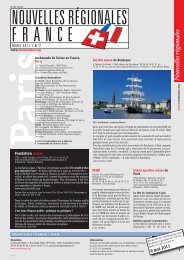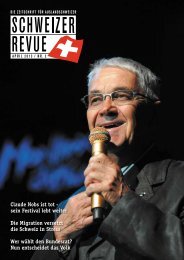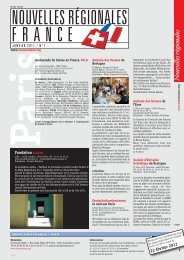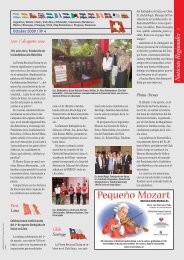Which energy will be best for Switzerland? Doris ... - Schweizer Revue
Which energy will be best for Switzerland? Doris ... - Schweizer Revue
Which energy will be best for Switzerland? Doris ... - Schweizer Revue
You also want an ePaper? Increase the reach of your titles
YUMPU automatically turns print PDFs into web optimized ePapers that Google loves.
16<br />
SWISS HIMALAYAN EXPEDITION<br />
Swiss Himalayan pioneers Fifty years ago, the third Swiss expedition to Mount Everest notched<br />
up the second and third conquest of the world’s highest peak. It also managed the first ascent<br />
of Lhotse, the highest “eight-thousander” as yet unscaled. Alain Wey looks back at one of the most<br />
successful expeditions in the history of Himalayan mountaineering. By Alain Wey.<br />
At 8,850 meters above sea level, the blue sky<br />
<strong>be</strong>gins to darken. To this day, towering Everest<br />
remains a source of yearning, almost as<br />
if it embodied an unattainable dream. Be<strong>for</strong>e<br />
the glitzy conquest of space, it was the ascent<br />
of the world’s tallest mountains that drove<br />
adventurers and researchers to new heights<br />
in the first half of the 20th century.<br />
There was even a kind of “competition”<br />
among the kings of the mountaineering nations.<br />
And yet it was Edmund Hillary, a<br />
<strong>be</strong>ekeeper from New Zealand of extraor-<br />
dinary strength, who with his sherpa Tenzing<br />
Norgay <strong>be</strong>came the first to reach the<br />
top of the highest mountain in the world<br />
in 1953. The names Hillary and Tenzing<br />
went down in the history books, and Britain<br />
basked in the knowledge that one of its<br />
antipodean settlers had got there first.<br />
However, it should not <strong>be</strong> <strong>for</strong>gotten that<br />
two expeditions from Geneva had <strong>be</strong>en<br />
<strong>for</strong>ced to turn back just 250 meters from<br />
the mythical peak in 1952. The Swiss Foundation<br />
<strong>for</strong> Alpine Research (SSAR) had<br />
<strong>be</strong>en trying to put together a new Himalayan<br />
expedition ever since.<br />
After much negotiation <strong>be</strong>tween 1953 and<br />
1956, the Swiss Everest Expedition was<br />
<strong>for</strong>med. This experienced group of mountaineers<br />
consisted of ten outstanding Swiss<br />
alpinists under the leadership of Al<strong>be</strong>rt Eggler,<br />
an honorary mem<strong>be</strong>r of the Swiss Alpine<br />
Club and at the time the club’s central president.<br />
The homogenous team comprising,<br />
amongst other things, a geographer, glaciologist,<br />
meteorologist, doctor, and chemist,<br />
SWISS REVIEW August 2006 / No. 4<br />
Photos: SFAR, Foundation <strong>for</strong> Alpine Research, Zurich<br />
The pictures are taken from the<br />
book “Everest – Lhotse, <strong>Schweizer</strong><br />
am Everest 1952 und 1956“,<br />
which documents the Swiss conquest<br />
of Everest in 1956 from<br />
Base Camp (upper right) to the<br />
summit (top right). The picture<br />
above shows Sherpa Tenzin on<br />
the right, with the Swiss team<br />
on the summit. On the right is the<br />
cashbox from which the sherpas‘<br />
daily fees were paid in cash.
















